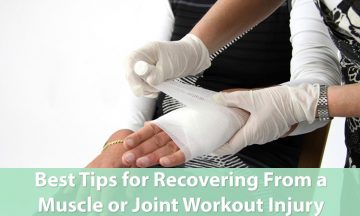Tips for Recovering From a Muscle or Joint Injury
Author: Harper Reid

There is nothing more frustrating for athletes than a muscle or joint workout injury, especially if it cuts precious time from training. However, you must be patient during the injury recovery process to allow your body to heal properly.
Here are four tips on how to recover from muscle or joint workout injuries from guest author Harper Reid – and how to prevent these injuries in the first place.
Preventive Measures
Obviously,training with the proper form for your exercise is crucial to preventing common workout injuries. For instance, if you’re weightlifting, only lift as much weight as you can handle. Even with the right amount of weights, you may still be at risk of injury if you do not use correct form. If you hyperextend your back at the top of a deadlift, you may risk injuring your lower back. Always use the right workout techniques, care for the parts of your body that take the most strain, communicate with your trainer, and use the proper equipment for your needs.
 Image Source: Pixabay, Creative Commons CC0
Image Source: Pixabay, Creative Commons CC0
Also, keep in mind that failing to warm up and not observing correct form for even low impact yoga workouts can cause pain in your back, shoulder, and neck muscles. The most important safety tip for yoga is to only do poses your body is comfortable with. If you feel your body resisting a pose, ask your teacher to stop and help you modify the pose accordingly so that your muscles are not unnecessarily strained.
Visiting the Doctor
It’s important to know the difference between pain and a real workout injury. Small nagging aches and pains are a normal part of training that you can usually work through. However, if you are experiencing severe, deep pain or pain that affects your sleep, visit your doctor. Your doctor will determine if you have a true workout injury and help you plan the most effective injury rehabilitation program. Physical therapists or trainers can help you correct bad posture habits that lead to sore joints and muscles.
Good Nutrition
Recovering from muscle and joint strains and injuries can take weeks or months, varying with the individual and the severity of the injury. You can speed your injury recovery process by fueling your body with nutritious food. Try your best to avoid foods that promote inflammation, such as processed white flour, fried foods, hot peppers, potatoes, eggplant, and alcohol. Foods like ginger, radishes, garlic and beets are also particularly helpful in aiding recovery.
 Image Source: PxHere, Creative Commons CC0
Image Source: PxHere, Creative Commons CC0
Also, keep hydrated – drink plenty of fresh juices made from organic, fresh vegetables, which are high in important vitamins and enzymes that help accelerate the recovery process. Joint and bone pain can sometimes be caused by nutrient deficiency, due to a lack of vitamin D [sun exposure], vitamin C [citrus fruits and vegetables like broccoli, cabbage, and spinach] or minerals like calcium [dairy products] and magnesium [leafy greens and nuts]. These nutrients work together: for instance, vitamin D and magnesium assist the body to absorb calcium. When you don’t have enough of these essential nutrients in your body, your joints may become swollen more easily and take longer to heal after workouts. Ensure you eat a balanced diet to counteract any vitamin deficiencies that may cause your joints extra stress during exercise.
Caring for Injuries
The RICE method – rest, ice, compression and elevation – is an excellent way to treat injuries like ankle or knee sprains. Workout injuries should be looked after immediately before they become worse. This means allowing injuries to rest until they are healed and giving the affected area the care it needs. Compressing the affected area with an ice pack will help reduce swelling and inflammation. Depending on where the workout injury is, elevation can be very helpful for the healing process. Many athletes find Epsom salt to be a great stress reliever for painful muscle cramps: mix a few tablespoons of Epsom salt into your hot bath and relax for at least 12 minutes to reap the most benefit.
One common mistake athletes make is training while their joint and muscle injuries are still recovering. Give your body a few days – after the pain is gone – to rest before you return to training. After an injury, carefully and slowly ease back into your routine.
Editor’s Disclaimer: The content of this article is provided for general informational purposes only and is not intended as, nor should it be considered a substitute for, professional medical advice. Do not use this for diagnosing or treating any medical or health condition. If you have or suspect you have a medical problem, promptly contact your professional healthcare provider.
______________________________________________________________________________

ABOUT THE AUTHOR
Harper Reid is a freelance writer from Auckland, New Zealand who is passionate about healthy living and fitness. When she’s not writing, you’ll find her practicing yoga or checking out the latest fitness trends. You can find more of her work on Tumblr.
